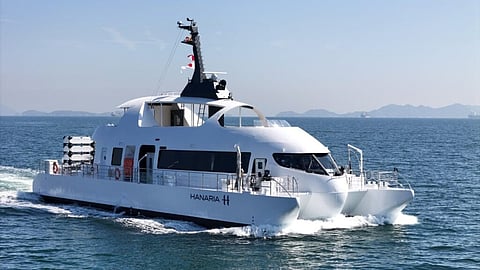VESSEL REVIEW | Hanaria – Hydrogen-powered commuter and sightseeing ferry for Japanese coastal routes
MOTENA-Sea, a company under Japan's MOL Group, has placed a new hybrid ferry into operational service in the waters off the city of Kitakyushu.
Hanaria was developed as a hybrid vessel that uses hydrogen and biodiesel as fuels. The hydrogen fuel cells consist of two 240kW units supplied by Yanmar, which also provided the vessel's power management and remote monitoring systems. The ferry was developed as part of a broader domestic project with the objective of identifying the feasibility of operating hydrogen-powered ships in Tokyo and other Japanese cities.
Multiple operating modes for greater flexibility

MOTENA-Sea said this is the first passenger ship in Japan that can select propulsion energy from hydrogen fuel cells, lithium-ion batteries, and biodiesel generators. This capability allows the vessel to achieve a greenhouse gas (GHG) emission reduction rate of between 53 and 100 per cent compared to conventional fossil-fuelled vessels of the same class. It also ensures greater operational flexibility, as it will permit selection of the most ideal propulsion method under a range of sailing conditions.

The vessel's operation also generates significant reductions in power source vibrations and noise in addition to eliminating exhaust gas odours, thus ensuring a more comfortable onboard environment for both passengers and crew.
The ferry has an LOA of 33 metres (108.2 feet), a beam of 10 metres (32.8 feet), a draught of approximately 1.4 metres (4.6 feet), a gross tonnage of 238, and a service speed of 10.5 knots. A twin-hull design was selected as a redundancy measure in the event of a shaft system issue. Two separate steering systems have also been incorporated to enhance operability when entering and leaving ports.
The vessel is also capable of "crabbing" laterally for safe berthing and unberthing in restrictive port waters.
Modern interior spaces

The ferry's main deck cabin features a large monitor and projector in the front, allowing this space of the vessel to be used for private events, environmental education, and conferences in addition to housing seated passengers during regular scheduled voyages. The upper deck is an open-air space with seats for accommodating passengers during days of clear weather.
The helm station is centre-aligned and features an ergonomic layout to enable only one operator to manoeuvre the vessel.

Hanaria was built at the Hiroshima facilities of Hongawara Ship Yard. It is being operated by local shipping company Kanmon Kisen on selected routes covering either popular religious shrines as well as nighttime city cruises and general sightseeing.
| Hanaria | |
| SPECIFICATIONS | |
| Type of vessel: | Commuter and sightseeing ferry |
| Flag: | Japan |
| Owner: | MOTENA-Sea, Japan |
| Operator: | Kanmon Kisen, Japan |
| Builder: | Hongawara Ship Yard, Japan |
| Length overall: | 33 metres (108.2 feet) |
| Beam: | 10 metres (32.8 feet) |
| Draught: | 1.4 metres (4.6 feet) |
| Steering systems: | 2 |
| Cruising speed: | 10.5 knots |
| Batteries: | Lithium-ion |
| Other electronics: | Yanmar power management system; Yanmar remote monitoring system |
| Other equipment installed: | 2 x Yanmar fuel cells, each 240 kW |
| Types of fuel: | Hydrogen; biodiesel |
| Accommodation: | Main deck cabin |
| Operational area: | Kitakyushu, Japan |
.png)

